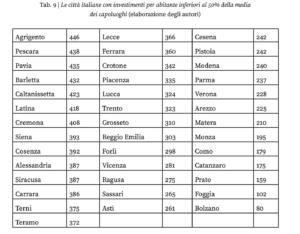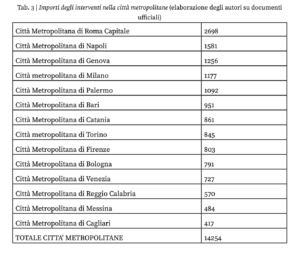Who will carry out the PNRR projects? Report

What will be the role of cities in the implementation of the NRP. Facts, numbers, comparisons, problems and scenarios in the paper of the University of Bologna
The National Recovery and Resilience Plan ( PNRR ) is an opportunity to relaunch the Italian urban fabric, the first after decades of austerity that have brought the level of public investment to an all-time low.
The objectives of the plan are, however, extremely ambitious and difficult to achieve. The working paper of the University of Bologna " ITALIAN CITIES AND PNRR " by professors Gianfranco Viesti, Carmela Chiapperini, Emanuela Montenegro of the University of Bari "Aldo Moro", wonders about the impact that the reforms envisaged by the PNRR may have on the Italian urban system and on the role of the Public Administration.
THE FOUR CIRCUMSTANCES
According to scholars, achieving the objectives of the plan will be far from simple. There are four circumstances that will have to materialize between now and 2026 and then at the end of the decade:
- “The allocation of resources for significant and territorially balanced public investments, in order to reach the entire urban system of the country;
- the realization of the planned projects within the terms of the PNRR and with a high executive quality;
- the activation, starting from the projects carried out (mainly infrastructural), of new and better services for the benefit of citizens and businesses;
- the mending of the many and diversified projects envisaged by the PNRR in coherent urban development strategies and their sharing with the citizens. "
THE NUMBERS OF THE PNRR
The PNRR is the largest investment and economic revitalization plan ever prepared by the European Union. The Plan has an overall size of € 235.6 billion. “On the financing side, it integrates the grants foreseen by the NGUE (68.9 billion) and the entire amount of the loans (122.6) from the Recovery and Resilience Facility (RFF, the financial lung of the NGEU). The Plan is therefore based on approximately 191 billion from the RFF . To these must be added 13.5 billion of the European REACT-EU program (a bridge program between the two cycles of the Structural Funds 2021-27) ". In addition, the Plan also provides for co-financing, through a "Complementary Fund", for 30 billion of national resources. 40% of the resources of the PNRR must be allocated to the regions of the South.
THE 11 MEASURES ANALYZED BY THE STUDY
The study analyzes 11 measures aimed at Italian cities, for resources amounting to over 20 billion euros . They concern urban regeneration interventions, on networks and vehicles for public transport, on ports, on judicial buildings and public residential buildings. In detail:
- Measure 1 PinQua (Innovative Program for the Quality of Living – PinQua) . It aims to reduce housing deprivation and to regenerate the socio-economic fabric of urban centers. It is financed 2.8 billion euros;
- It measures 2 Integrated Urban Floors . The intervention is intended entirely for metropolitan cities, with the aim of improving their suburbs. It has a total of 2.7 billion euros;
- Measure 3 and 3bis Urban regeneration . Intended for municipalities with more than 15,000 inhabitants, it aims to reduce situations of marginalization and social degradation. Resources of € 3.4 billion have been allocated;
- Measure 4 Great cultural attractors . It is dedicated to the recovery of cultural sites and historical complexes, largely inserted in urban contexts. It can count on a total of 3.6 billion euros;
- Measure 5 Rapid mass transport . It aims to develop a sustainable mobility network. It has a total of € 4.4 billion at its disposal;
- Measure 6 Renewal of bus fleets . The investment aims to renew the green bus and train fleets. The total cost of the investment is 3.639 billion, plus 600 million from the Complementary Fund;
- Measure 7 Ports. The renewal of the port infrastructures, most of which, located in the capital city, can benefit from 3.47 billion. Some of these interventions have a unitary dimension of great importance, as in the cases of Genoa, Trieste and Naples.
- Measure 8 Ports in SEZs . The measure concerns urban ports financed under the Special Economic Zones (SEZ) of the South. The PNRR allocates € 630 million;
- Measure 9 Projects for Rome . The Projects for Rome are divided into Caput Mundi – New Generation EU for major tourist events, with resources equal to 500 million), and the Cinecittà Project: Film Industry Development, with 300 million;
- It measures 10 Judicial Citadels . The intervention aims to make 290,000 square meters of offices, courts and judicial towns more efficient, technologically improving the provision of services and recovering the historical heritage. It has 411.7 million euros available;
- Measure 11 Public housing . The project aims to improve the energy efficiency, resilience and seismic safety of the public residential heritage. It is financed with 2 billion from the complementary fund to the PNRR.
ALLOCATION OF PNRR RESOURCES IN THE PUBLIC ADMINISTRATION
There are some disparities in the allocation of resources. “In metropolitan cities, investments are much more intense in the capitals than in the other municipalities; Rome, Naples, Turin and Milan are the recipients of lower investments, measured in per capita, compared to the others ”. Furthermore, “ in 40 provincial capitals, the intensity of investments is less than half the average . Among them, important realities of the weakest regions, Calabria, Sicily and Sardinia ". Over two thirds of the resources of the measures analyzed in the paper “will be used in the 14 Italian metropolitan cities, in total over 14 billion. “This depends on the existence of interventions specifically dedicated to them, on the allocation criteria analyzed in the previous paragraph and on the success of the various administrations in the tenders”. The city The city with the greatest investment intensity is Genoa, due to the interventions destined for the port . For the same reason Reggio Calabria has an above-average investment intensity. 38% of the total investments allocated between cities are destined to the cities of the South, with great differences between measure and measure according to the criteria used: but they tend to be concentrated only in some of them.

THE CINDERELLA OF INVESTMENTS: BOLZANO, FOGGIA AND PRATO
Forty Italian cities are recipients of interventions for a per capita amount lower than half the average of the provincial capitals. They are distributed between North, Center and South but it is in the South that important cities such as Teramo and Pescara, Foggia, Barletta, Lecce, Cosenza, Crotone and Catanzaro, Agrigento, Caltanissetta, Ragusa and Syracuse are penalized. Singular is the case of Foggia where, based on the measures analyzed by the study, interventions for 15 million euros will be carried out "a figure lower than that destined for the tiny municipality of Accadia, in its province, selected in the" villages "call and which will of 20 million ".

PNRR AND PUBLIC ADMINISTRATION: THE ROLE OF LOCAL ADMINISTRATIONS
Ultimately, the PNRR is a public investment plan “declined along sector lines in the various measures”, which focuses on the role of the Public Administration. In our country, public investments are made both by large companies “belonging to the so-called national“ extended public sector ”such as Railways, Terna, Infratel and local ones such as municipal companies, and by public administrations. " In 2021 out of a total of public investments equal to 24 billion – the study reads -, about half was made by the municipalities". For this reason, the local Public Administration plays a fundamental role within the PNRR.
CONTRACTION OF PUBLIC EMPLOYMENT STAFF
In the last 20 years there has been a very strong contraction of the staff of the municipalities, and of the local administrations as a whole. In 2019, total employees " were just under 445,000 compared to almost 579,000 in 2010 " and according to "recent reconstructions by the Bank of Italy, between 2008 and 2019 the staff of the territorial bodies of the regions with ordinary statute decreased from 94 to 72 employees per ten thousand inhabitants (-23%) in the Center-North and from 95 to 64 employees (-33%, but with even greater reductions in Campania) in the South ”. The contraction in the major cities was stronger. “ In the South, in the municipalities with more than 250,000 inhabitants, there was a drop from 120 to 66 employees per ten thousand inhabitants , with a drop of 45%; in the municipalities with more than 250,000 inhabitants in the regions with special status, it has gone from 148 to 101, with a reduction of 32%. Even in the municipalities with more than 250,000 inhabitants in the North, there was a reduction, albeit less dramatic, from 89 to 67 (-25%). Even in the average municipalities (60,000 – 250,000 inhabitants) the trends were towards a significant reduction, once again stronger in those of the regions with ordinary status in the South ”.
THE QUALITY OF THE HUMAN RESOURCES OF THE PUBLIC ADMINISTRATION
The study of the University of Bologna is concerned about the implementation of PNRR projects for which there is a risk of lack of adequate professionalism in the PA. " The actual ability of Italian municipalities to carry out all these investments on time and with quality is worrying, in light of the fact that the administrations are very poor in personnel and technical skills". The picture is even more worrying in the cities of the South. “ Unfortunately, the Plan has not foreseen structural interventions for their strengthening ; various appropriate initiatives are underway, defined subsequently, in this sense but they still appear insufficient. The most important effect of the PNRR will unfold after these investments are made, and from them new and better services will be generated for citizens and businesses: but this will depend so much on the current budget of the administrations (currently unknown), as well as their ability to link interventions in coherent urban strategies, participated by citizens ”.
This is a machine translation from Italian language of a post published on Start Magazine at the URL https://www.startmag.it/economia/chi-realizzera-i-progetti-del-pnrr-report/ on Thu, 03 Nov 2022 09:46:09 +0000.
